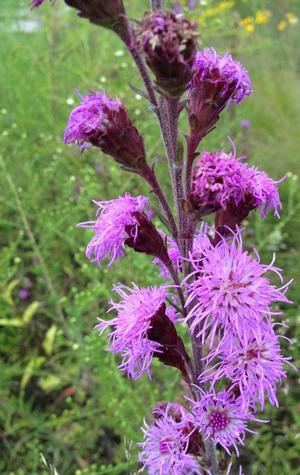New Moon Nurseries
Liatris ligulistylis
Rocky Mountain blazing star
Native to North America
FIRST IMPRESSIONS: Liatris ligulistylis is a showy drought tolerant perennial wildflower. Plants are generally 1-3’ tall and unbranched with narrow somewhat grass-like leaves. In late summer spectacular rosy purple flower spikes are frequented by Monarchs, Painted Ladies and other supermodel butterflies. Plants are tough and drought tolerant prospering in sunny sites with mesic or lean dry soils.
HABITAT & HARDINESS: Liatris ligulistylis occurs in central North America from Alberta to New Mexico and east to Manitoba, Wisconsin and Missouri.
Habitats include open rocky woods, rocky slopes, mesic prairies, moist meadows and gravelly stream banks.
Plants are hardy from USDA Zones 3-8.
PLANT DESCRIPTION: Liatris ligulistylis is a sturdy perennial that produces an upright central stalk from a rounded woody underground corm. The stems are often reddish and clothed in short hairs.
Leaves are long and narrow with the largest basal leaves being as much as 1.5” wide and 3-10” long. The blades have whitish midribs and are covered with short white hairs. They become progressively smaller as the stalk rises and look like tiny bracts on the upper stems.
In late summer flower stalks erupt into spikey inflorescences composed of many orchid colored florets. The florets are arranged into 1” button-like heads held on short stalks. Each head contains 30-100 disc florets with curly exerted styles that give a bottlebrush effect.
Blooming begins at the top of the flower stalk and progresses downward. The flower display continues from late summer until autumn for up to 6 weeks. Soft tufts of fluffy golden brown achenes follow.
Plants are generally 1-3’ tall but occasionally up to 5’ with a 1’ spread.
CULTURAL & MAINTENANCE NEEDS: Liatris ligulistylis flourishes in sunny sites with dry or moist well drained soils.
Plants tolerate light shade, drought, heat, humidity and poor infertile, shallow rocky, sandy or alkaline soils. Avoid planting in sites that are wet during winter.
This species will grow in most average well drained garden soils. Plants will flop and may need staking if soil is too rich or moist.
LANDSCAPE USES: This is a great vertical accent for a Wildlife Garden, Prairie or Meadow. Plants are also used as Cut Flowers, Butterfly Nectar Plants or as part of a Grouping or Mass Planting. Liatris ligulistylis has Showy Blooms and is appropriate for Cottage Gardens, Water-wise Landscapes, Low Maintenance Plantings, Perennial Borders, Rock Gardens and Roadsides.
COMPANION & UNDERSTUDY PLANTS: Try pairing Liatris ligulistylis with Andropogon gerardii, Asclepias tuberosa, Aster oblongifolius, Coreopsis tripteris, Monarda x 'Peter's Fancy Fuchsia', Echinacea purpurea or Eryngium yuccifolium.
Liatris aspera would be an appropriate replacement due to similar flowers and habitat needs.
TRIVIA: Liatris ligulistylis is also known as Rocky Mountain Gayfeather, Rocky Mountain Liatris, Meadow Gayfeather, Northern Plains Blazingstar.
The very similar species, Liatris aspera, has flower heads that are stalkless, flaring floral bracts and a preference for drier conditions. Liatris ligulistylis has stalked flower heads, floral bracts that are flattened and a preference for moister sites.
Long tongued bees, hummingbirds and hummingbird moths visit the flowers. The blooms are particularly attractive to Monarch butterflies along with Swallowtail, Sulphur, Hairstreak, Fritillary, Painted Lady and Red Admiral butterflies. Goldfinches feed on the seed. Plants are occasionally nibbled by rabbits and deer.
Height:
1-3 ftSpread:
1 ftSpacing:
18 inUSDA Hardiness Zone:
3-8Bloom Color:
PurpleLiatris ligulistylis Characteristics
Attracts Wildlife
- Pollinators
- Butterflies
Attributes
- Long Blooming
- East-Coast Native
- Drought Tolerant
- Cut Flower
- Rock Garden
- Naturalizing
Exposure
- Full Sun
Flowering Months
- September
- August
- July
Foliage Color
- Green
Growth Rate
- Slow
Season of Interest (Foliage)
- Fall
- Summer
- Spring
Soil Moisture Preference
- Dry to Moist
